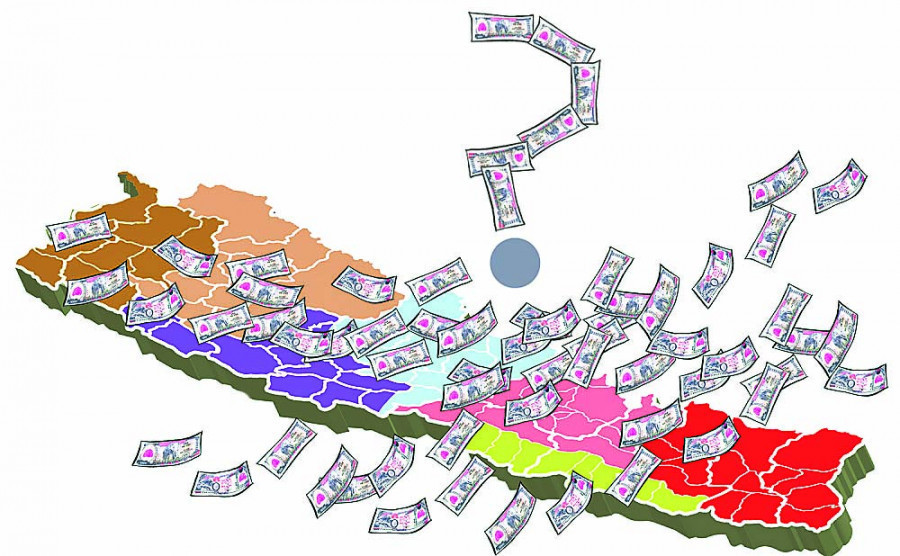Columns
Promises and perils of fiscal federalism
It is time to reorient our fiscal architect to bring economic wellbeing to citizens.
Gopi K Khanal
Fiscal federalism aims to boost the economic empowerment and financial wellbeing of people by strengthening the fiscal capacities of all tiers of government. It is not just about the distribution of spending, taxing and borrowing powers among different tiers of government but also about sharing the responsibility of producing equitable economic fruits across the country. Unfortunately, in Nepal, this underlying premise and the core constructs of fiscal federalism have not been fully respected, if not neglected.
The foundation of fiscal federalism is built on four pillars: Expenditure assignment, revenue assignment, inter-governmental fiscal transfers and public debt management. Expenditure assignment divides spending responsibilities among different levels of government. The Constitution of Nepal has listed the exclusive and concurrent functions of federal, provincial and local levels. Sub-national entities have the authority to make law in exclusive functions. However, in concurrent functions, lower tiers of government have no right to enact any law that contradicts the provisions of a law passed by upper levels of government. In practice, there are issues of overlapping and duplication among the laws passed by governments. The unbundling report, approved by the federal cabinet in 2017, has detailed the concurrent functions listed in the constitution. Nevertheless, federal sectoral ministries have been reluctant to transfer many of the functions that fall under the spending responsibilities of sub-national government.
Revenue assignment—the distribution of power to choose the tax base, assess the tax base, decide the tax rate, collect the tax, and retain earnings from tax—has been highly skewed in favour of the central government. Provinces have limited taxing powers, as most broad-based taxes, including custom duty, income tax, excise duty and value-added tax, are within the federal jurisdictions. However, there are provisions for sharing revenues from value-added tax and internal excise duty to the sub-national government. Royalties from natural resources are shared on a derivative basis. Local governments enjoy relatively more taxing powers than the provinces. Property tax, house rent, small business tax and land revenue are the major sources of local taxes. The province and local levels share revenues from entertainment taxes, advertisement taxes and house and land registration fees. There are conflicts over the mobilisation of rental tax from corporate sectors between the local government and the Ministry of Finance, as well as conflicts among provinces and local governments regarding the sharing of revenues from sales of sand and gravel.
The mismatch between the spending responsibilities and revenue-generating power at the federal, provincial and local levels has created intense fiscal gaps, prompting intergovernmental fiscal transfer to be an integral part of fiscal federalism in Nepal. There are mandatory provisions of fiscal equalisation grant, conditional grant, revenue sharing and sharing of natural resources royalties from centre to province, local levels and province to local. For the fiscal year 2022-23, the total share of fiscal transfers, including revenue sharing, was 33.1 percent of the federal budget, which is 12.3 percent of the GDP of that fiscal year. Fiscal transfers have helped subnational governments meet their service delivery and development expenditure needs. However, prolonged transfer addiction may invite fiscal imprudence, if not fiscal bleeding, at the sub-national level. It may result in a flypaper effect—stimulating the local government to spend more than the increase in local income of the same size.
Alternative financing mechanisms are necessary for capital-intensive investment that fosters growth and employment. Public borrowing is one such mechanism, especially when the level of fiscal transfers and volume of own-source revenues are not sufficient to finance lumpy public investment. Even the sub-national governments can take advantage of borrowing to raise funds. However, Nepal has adopted hard budget constraints with limited and restricted borrowing powers on sub-national borrowings, with National Natural Resource and Fiscal Commission setting the annual limit of internal borrowing for all levels of government. Provinces have not yet practiced public borrowings, while municipalities in Nepal have been borrowing from Town Development Fund.
According to the Ministry of Finance, Nepal’s debt-to-GDP ratio for FY 2022-23 is 41.3 percent. Given Nepal’s high reliance on remittance and low export volume, any increase in the debt-to-GDP ratio above the 40 percent threshold may invite macro-fiscal risks. According to International Monetary Fund, the overall fiscal deficit is expected to reach 4.5 percent of GDP for 2022-23. A fiscal deficit beyond 3 percent of GDP is not considered a healthy symptom.
Fiscal federalism has both positive and negative effects. On the upside, it has devolved the public fund across the countries, helping people to access local services. It has ensured some level of reliable fiscal space for the provincial government to carry on regional development projects. Additionally, it has reduced the size of the common pool problem, diverting the public fund to the constituencies of powerful political and bureaucratic elites to some extent. On the downside, fiscal federalism has been subject to fiscal risks and fiduciary risks. The size of current expenditure overwhelmingly dominates Nepal’s yearly budget. For instance, in the fiscal year 2023-24 budget, the share of current expenditure, capital expenditure and financial services is 65.20 percent, 17. 25 percent, and 17.55 percent, respectively. This is a symptom of a steady state, which means that resources are consumed to maintain the status quo rather than being utilised to increase capital stock.
According to the 60th annual report published by the Office of Auditor General, in 2023, the total irregularities reached Rs587.34 billion. This is an alarming figure and manifests a high level of fiduciary risks. The crux of the public fund involves spending others’ money, and spending for beneficial changes is as important as timely spending to avoid future costs. However, there has been a decrease in the capacity for capital expenditure. For instance, in the fiscal year 2021-22, only 57.2 percent of the allocated budget of capital expenditure was spent. The federal system also has a decreasing trend in the total share of capital expenditure budget. The latest economic survey of Nepal reveals that the total share of capital expenditure budget decreased to 23.2 percent of the total budget in the fiscal year 2021-22 from 29.7 percent in 2016-17.
Fiscal federalism is the life blood of federal governance that must be directed to bring benefits for all citizens. It should not be devised to consolidate power for political and bureaucratic elites; instead, it should strengthen the legitimacy of the federal system. Nepal has successfully built the basic structure of the federal government in a short time. Now, it is time to reorient our fiscal architect to bring economic wellbeing to citizens. We must restrain all tiers of government from unproductive spending. Our efforts must be directed towards minimising the current perils and enhancing the promise of fiscal federalism.




 18.12°C Kathmandu
18.12°C Kathmandu















